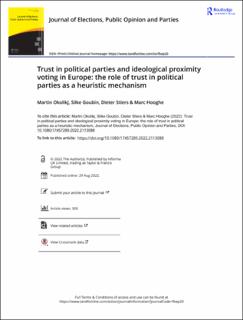| dc.contributor.author | Okolikj, Martin | |
| dc.contributor.author | Goubin, Silke | |
| dc.contributor.author | Stiers, Dieter | |
| dc.contributor.author | Hooghe, Marc | |
| dc.date.accessioned | 2022-10-25T13:59:23Z | |
| dc.date.available | 2022-10-25T13:59:23Z | |
| dc.date.created | 2022-10-19T14:30:50Z | |
| dc.date.issued | 2022 | |
| dc.identifier.issn | 1745-7289 | |
| dc.identifier.uri | https://hdl.handle.net/11250/3028235 | |
| dc.description.abstract | Previous studies have investigated to what extent voters can achieve proximity between their preferences and the positions of the party they vote for. Combining data from the European Social Survey and the Chapel Hill Expert Survey, we investigate whether trust in political parties increases ideological proximity voting. We argue that voters use their level of trust in parties as a heuristic mechanism. First, trust can increase proximity voting because citizens need to trust that political parties will take voters’ policy preferences into account when in government. Second, we examine whether low-trusting voters tend to cast a protest vote, and do not engage in ideological proximity voting. We test this assumption regarding three determinants of the vote choice: general left-right ideology views, preferences for income redistribution, and anti-immigrant sentiments. We find that ideological proximity voting is indeed moderated by trust: those who trust political parties are more likely to cast a vote based on their policy preferences, while those who distrust tend to vote for protest parties. Nevertheless, also among protest voters, trust is conducive for higher levels of proximity voting. | en_US |
| dc.language.iso | eng | en_US |
| dc.publisher | Taylor & Francis | en_US |
| dc.rights | Attribution-NonCommercial-NoDerivatives 4.0 Internasjonal | * |
| dc.rights.uri | http://creativecommons.org/licenses/by-nc-nd/4.0/deed.no | * |
| dc.title | Trust in political parties and ideological proximity voting in Europe: the role of trust in political parties as a heuristic mechanism | en_US |
| dc.type | Journal article | en_US |
| dc.type | Peer reviewed | en_US |
| dc.description.version | publishedVersion | en_US |
| dc.rights.holder | Copyright 2022 the authors | en_US |
| cristin.ispublished | true | |
| cristin.fulltext | original | |
| cristin.qualitycode | 1 | |
| dc.identifier.doi | 10.1080/17457289.2022.2113088 | |
| dc.identifier.cristin | 2062872 | |
| dc.source.journal | Journal of Elections, Public Opinion and Parties. 2022. | en_US |
| dc.identifier.citation | Journal of Elections, Public Opinion and Parties | en_US |

